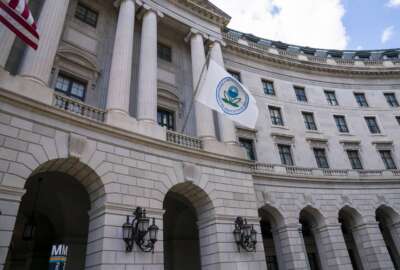Conflict of interest comes to light in the EPA’s small business innovation research program
The federal Small Business Innovation Research Program (SBIR) has aided neophyte companies in a variety of domains. The EPA is among the agencies with an active...
The federal Small Business Innovation Research Program (SBIR) has aided neophyte companies in a variety of domains. The EPA is among the agencies with an active SBIR program. But there’s a nagging problem, according to the EPA’s office of inspector general: conflicts of interest in SBIR contracts. For more, Federal Drive with Tom Temin spoke with IG Special Agent Nic Evans.
Interview Transcript:
Tom Temin So just briefly, for the uninitiated, explain what SBIR is and how it works and how the contracts get let under SBIR?
Nic Evans Absolutely. So the SBIR is a set aside program for small businesses to engage in federally funded research and development. The goal is commercialization of an innovative product. Currently, 11 federal agencies and departments participate. The budget is 3.2% of the agency’s extramural research and development budget. Total SBIR budget is approximately 4 billion across the federal government, and of that, as of 2020, a little over half was provided in the form of contracts, while the other half was provided as grants.
Tom Temin And how much does EPA have under its SBIR program?
Nic Evans Approximately $5 million.
Tom Temin Okay, so it’s not giant dollars. Are these contracts, by the way, under the Federal Acquisition Regulation, are there separate rules for SBIR contracts?
Nic Evans Yes, they’re there under the Federal Acquisition Regulations, but they also fall under the EPA’s acquisition regulations.
Tom Temin Right. So you have a supplement to the FAR that is just for EPA?
Nic Evans Yes, that’s correct.
Tom Temin Okay. Well, that puts you right up there with the Defense Department. So congratulations on that one. And what prompted you to take a look at the conflict of interest possibility in the SBIR contract?
Nic Evans Well, we are focusing greatly right now on preventing and detecting fraud, waste and abuse in EPA’s programs to include their contracts and grants. The EPA was awarded approximately $100 billion via the Infrastructure Investment and Jobs Act and the Inflation Reduction Act. So we’re actively right now looking for ways to prevent and detect fraud, waste and abuse. The Federal Government’s SBIR program has a history of fraud. As such, the Office of Inspector General is statutorily mandated to prevent and detect fraud, waste and abuse in the SBIR program. And we’ve identified concerns about conflicts of interest from previous OIG investigations.
Tom Temin Got it. And so is a conflict of interest per say, fraud, or could it just be an indicator of fraud?
Nic Evans Yes, it’s just an indicator of fraud.
Tom Temin Okay. So you really don’t want conflicts of interest then at all in contracts. And so how does it work? I mean, what did you find in this latest round of looking at what did you look at and what was your sample and so on?
Nic Evans So we identified four provisions and clauses in the Environmental Protection Agency acquisition regulation that related to actual or potential conflicts of interest that we felt should be included in SBIR solicitations in contracts.
Tom Temin And just briefly, what was your methodology for this look-see?
Nic Evans Sure. We reviewed recent SBIR solicitations and contracts to see what provisions they contained regarding conflicts of interest.
Tom Temin All right. And what did you find?
Nic Evans What we found was that the provisions varied between solicitations and contracts, and that the OIG’s standpoint is that we wanted to include the strongest conflict of interest provisions possible to prevent fraud, waste and abuse in the program.
Tom Temin We’re speaking with Nic Evans. He’s special agent in charge of the Eastern Division of the Office of Investigations, part of the EPA’s Office of Inspector General. And you did find evidence of conflict of interest in a couple of cases, right?
Nic Evans Yes, we did. We identified two different criminal investigations that involved potential conflicts of interest.
Tom Temin And what form did it take? I mean, who was the conflict with? Was it within the contractors or was it between EPA staff and the contractor? What was the format of it?
Nic Evans And one, we had a husband and wife that one of them was representing the awardee that had received the SBIR award. And the other spouse was representing the subcontractor, which was a university. In another example, we identified a husband and wife team where the husband would represent the small business concern and the wife would be the senior scientist on the project. And on the flip side, they would flip those roles and be able to apply for more SBIR awards.
Tom Temin So if they had said, for example, under the regulations, look, we’re the same household here and this is how we’re going about that. Would that have helped the situation? Would EPA have should they accept that kind of thing, or is it prima facie conflict of interest when two people that have differing roles are under the same roof?
Nic Evans Sure. Our standpoint is the more information, the better. The EPA could make a better determination as to whether they would like to make the award if they had that information available.
Tom Temin And just to clarify, in the solicitations that led to these contracts, were those four provisions in the EPA FAR supplement related to conflict of interest? Were they included?
Nic Evans Not all clauses were included.
Tom Temin So it sounds like your recommendation is start including all those clauses.
Nic Evans Yes, sir.
Tom Temin Is that your major recommendation here?
Nic Evans That’s our recommendation. Our recommendation is just to include the strongest conflict of interest provision as possible to ensure that the government is getting a fair deal.
Tom Temin And are there any mechanisms you think that the contracting staff can use to make sure people are following the provisions? Because if they’re sort of liars on one end, just because something’s in a solicitation doesn’t mean they’re going to follow that either.
Nic Evans Yes, it doesn’t. You’re correct. However, I think that if what we don’t know is what we don’t know. And that by including these provisions, that hopefully folks will be honest and the government can make a better decision on whether they would like to make that award.
Tom Temin Sure. And what was the agency or the program, the SBIR program’s reaction to the recommendations in the report?
Nic Evans As of yet, I’m unaware of the reactions.
Tom Temin Okay. But we hope they agree, in general.
Nic Evans Absolutely.
Tom Temin And you also in the report mentioned concern about SBIR dollars somehow ending up in the hands of companies in countries that are adversarial to the United States. And tell us more about that idea.
Nic Evans Conflicts of interest could arise due to foreign financial ties or obligations where the contractor may transfer the innovative research developed from federal research and development funding to a country that’s adversarial to the United States.
Tom Temin And do we know that’s happened at all, or is that just another one of those potentials that they need to be keeping an eye out for?
Nic Evans It’s certainly a concern.
Tom Temin And by the way, to the extent that what types of research and innovation is EPA after with its SBIR program?
Nic Evans There’s a variety of different topics. It is information that’s available on the EPA website. What we’re looking for here is items related to clean technology, the manufacturing of efficient and long lasting, environmentally safe batteries, things of that nature.
Tom Temin And maybe making smoke from fires disappear.
Nic Evans Hopefully.
Copyright © 2024 Federal News Network. All rights reserved. This website is not intended for users located within the European Economic Area.
Tom Temin is host of the Federal Drive and has been providing insight on federal technology and management issues for more than 30 years.
Follow @tteminWFED
Related Stories






